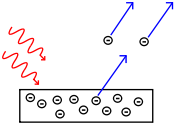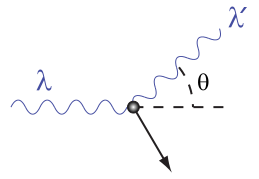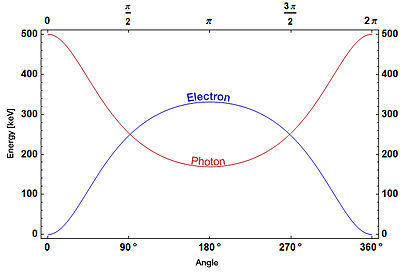- Compton scattering
-
Light–matter interaction 
Low-energy phenomena: Photoelectric effect Mid-energy phenomena: Compton scattering High-energy phenomena: Pair production In physics, Compton scattering is a type of scattering that X-rays and gamma rays (both photons with different energy ranges) undergo in matter. The inelastic scattering of photons in matter results in a decrease in energy (increase in wavelength) of an X-ray or gamma ray photon, called the Compton effect. Part of the energy of the X/gamma ray is transferred to a scattering electron, which recoils and is ejected from its atom (which becomes ionized), and the rest of the energy is taken by the scattered, "degraded" photon. Inverse Compton scattering also exists, in which a charged particle transfers part of its energy to a photon.
Contents
Introduction
Compton scattering is an example of inelastic scattering, because the wavelength of the scattered light is different from the incident radiation. Still, the origin of the effect can be considered as an elastic collision between a photon and an electron. The amount the wavelength changes by is called the Compton shift. Although nuclear Compton scattering exists,[1] Compton scattering usually refers to the interaction involving only the electrons of an atom. The Compton effect was observed by Arthur Holly Compton in 1923 at Washington University in St. Louis and further verified by his graduate student Y. H. Woo in the years following. Compton earned the 1927 Nobel Prize in Physics for the discovery.
The effect is important because it demonstrates that light cannot be explained purely as a wave phenomenon. Thomson scattering, the classical theory of an electromagnetic wave scattered by charged particles, cannot explain low intensity shifts in wavelength. (Classically, light of sufficient intensity for the electric field to accelerate a charged particle to a relativistic speed will cause radiation-pressure recoil and an associated Doppler shift of the scattered light,[2] but the effect would become arbitrarily small at sufficiently low light intensities regardless of wavelength.) Light must behave as if it consists of particles to explain the low-intensity Compton scattering. Compton's experiment convinced physicists that light can behave as a stream of particle-like objects (quanta) whose energy is proportional to the frequency.
The interaction between electrons and high energy photons (comparable to the rest energy of the electron, 511 keV) results in the electron being given part of the energy (making it recoil), and a photon containing the remaining energy being emitted in a different direction from the original, so that the overall momentum of the system is conserved. If the photon still has enough energy left, the process may be repeated. In this scenario, the electron is treated as free or loosely bound. Experimental verification of momentum conservation in individual Compton scattering processes by Bothe and Geiger as well as by Compton and Simon has been important in disproving the BKS theory.
If the photon is of lower energy, but still has sufficient energy (in general a few eV to a few KeV, corresponding to visible light through soft X-rays), it can eject an electron from its host atom entirely (a process known as the photoelectric effect), instead of undergoing Compton scattering. Higher energy photons (1.022 MeV and above) may be able to bombard the nucleus and cause an electron and a positron to be formed, a process called pair production.
Description of the phenomenon
See also: Klein-Nishina formulaBy the early 20th century, research into the interaction of X-rays with matter was well underway. It was observed that when X-rays of a known wavelength interact with atoms, the X-rays are scattered through an angle θ and emerge at a different wavelength related to θ. Although Classical electromagnetism predicted that the wavelength of scattered rays should be equal to the initial wavelength;[3], multiple experiments had found that the wavelength of the scattered rays was greater than the initial wavelength.[3]
In 1923, Compton published a paper in the Physical Review which explained the X-ray shift by attributing particle-like momentum to “photons” which Einstein had conceptualized as elements of light “quantized” as containing a specific amount of energy depending only on the frequency of the light. In his paper, Compton derived the mathematical relationship between the shift in wavelength and the scattering angle of the X-rays by assuming that each scattered X-ray photon interacted with only one electron. His paper concludes by reporting on experiments which verified his derived relation:
where
- λ is the initial wavelength,
- λ' is the wavelength after scattering,
- h is the Planck constant,
- me is the rest mass of the electron,
- c is the speed of light, and
- θ is the scattering angle.
The quantity h⁄mec is known as the Compton wavelength of the electron; it is equal to 2.43×10−12 m. The wavelength shift λ′ − λ is at least zero (for θ = 0°) and at most twice the Compton wavelength of the electron (for θ = 180°).
Compton found that some X-rays experienced no wavelength shift despite being scattered through large angles; in each of these cases the photon failed to eject an electron.[3] Thus the magnitude of the shift is related not to the Compton wavelength of the electron, but to the Compton wavelength of the entire atom, which can be upwards of 10 000 times smaller.
Derivation of the scattering formula
A photon γ with wavelength λ collides with an electron e in an atom, which is treated as being at rest. The collision causes the electron to recoil, and a new photon γ' with wavelength λ' emerges at angle θ from the photon's incoming path. Let e' denote the electron after the collision. Compton allowed for the possibility that the interaction would sometimes accelerate the electron to speeds sufficiently close to the velocity of light to require the application of Einstein's special relativity theory to properly describe its energy and momentum.
At the conclusion of Compton's 1923 paper, he reported results of experiments confirming the predictions of his scattering formula thus supporting the assumption that photons carry directed momentum as well as quantized energy. At the start of his derivation, he had postulated an expression for the momentum of a photon from equating Einstein's already established mass-energy relationship of E = mc2 to the quantized photon energies of hf which Einstein has separately postulated. If mc2 = hf, the equivalent photon mass must be hf / c2. The photon's momentum is then simply this effective mass times the photon's frame-invariant velocity c. For photons, p = hf / c, and thus hf can be substituted for pc for all photon momentum terms which arise in course of the derivation below. The derivation which appears in Compton's paper is more terse, but follows the same logic in the same sequence as the following derivation.
The conservation of energy E merely equates the sum of energies before and after scattering.
Compton postulated that photons carry momentum;[3] thus from the conservation of momentum, the momenta of the particles should be similarly related by

- in which (pe) is omitted on the assumption it is effectively zero.
The photon energies are related to the frequencies by


- where h is Planck's constant.
Before the scattering event, the electron is treated as sufficiently close to being at rest that its total energy consists entirely of the mass-energy equivalence of its rest mass me:
After scattering, the possibility that the electron might be accelerated to a significant fraction of the speed of light, requires that its total energy be represented using the relativistic energy-momentum relation:
Expand the conservation of energy statement in terms of the foregoing.
Square both sides and isolate the (only) post-scattering electron term on the left.
From the conservation of momentum,
Then by making use of the scalar product,
Anticipating that pγc is replaceable with hf, multiply both sides by c2:
After replacing the photon momentum terms with hf / c, the foregoing becomes:
Now equating equations 1 and 2,
Then dividing both sides by (2h f f 'me c) yields
Since

Applications
Compton scattering
Compton scattering is of prime importance to radiobiology, as it is the most probable interaction of gamma rays and high energy X rays with atoms in living beings and is applied in radiation therapy.[4]
In material physics, Compton scattering can be used to probe the wave function of the electrons in matter in the momentum representation.
Compton scattering is an important effect in gamma spectroscopy which gives rise to the Compton edge, as it is possible for the gamma rays to scatter out of the detectors used. Compton suppression is used to detect stray scatter gamma rays to counteract this effect.
Inverse Compton scattering
Inverse Compton scattering is important in astrophysics. In X-ray astronomy, the accretion disc surrounding a black hole is believed to produce a thermal spectrum. The lower energy photons produced from this spectrum are scattered to higher energies by relativistic electrons in the surrounding corona. This is believed to cause the power law component in the X-ray spectra (0.2-10 keV) of accreting black holes.
The effect is also observed when photons from the cosmic microwave background move through the hot gas surrounding a galaxy cluster. The CMB photons are scattered to higher energies by the electrons in this gas, resulting in the Sunyaev-Zel'dovich effect. Observations of the Sunyaev-Zel'dovich effect provide a nearly redshift-independent means of detecting galaxy clusters.
Some synchrotron radiation facilities scatter laser light off the stored electron beam. This Compton backscattering produces high energy photons in the MeV to GeV range[5] subsequently used for nuclear physics experiments.
See also
- List of astronomical topics
- List of physics topics
- Compton Gamma Ray Observatory
- Klein–Nishina formula
- Pair production
- Peter Debye
- Photoelectric effect
- Thomson scattering
- Timeline of cosmic microwave background astronomy
- Walther Bothe
References
- ^ P Christillin (1986). "Nuclear Compton scattering". J. Phys. G: Nucl. Phys. 12 (9): 837–851. Bibcode 1986JPhG...12..837C. doi:10.1088/0305-4616/12/9/008. http://www.iop.org/EJ/abstract/0305-4616/12/9/008.
- ^ http://www.lle.rochester.edu/media/publications/documents/theses/Moore.pdf
- ^ a b c d Taylor, J.R.; Zafiratos, C.D.; Dubson, M.A. (2004). Modern Physics for Scientists and Engineers (2nd ed.). Prentice Hall. pp. 136–9. ISBN 013805715X.
- ^ Camphausen KA, Lawrence RC. "Principles of Radiation Therapy" in Pazdur R, Wagman LD, Camphausen KA, Hoskins WJ (Eds) Cancer Management: A Multidisciplinary Approach. 11 ed. 2008.
- ^ "GRAAL home page". Lnf.infn.it. http://www.lnf.infn.it/~levisand/graal/graal.html. Retrieved 2011-11-08.
Further reading
- S. Chen; H. Avakian, V. Burkert, P. Eugenio, the CLAS collaboration (2006). "Measurement of Deeply Virtual Compton Scattering with a Polarized Proton Target". Physical Review Letters 97 (7): 072002. arXiv:hep-ex/0605012. Bibcode 2006PhRvL..97g2002C. doi:10.1103/PhysRevLett.97.072002. PMID 17026221.
- Compton, Arthur H. (May 1923). "A Quantum Theory of the Scattering of X-Rays by Light Elements". Physical Review 21 (5): 483–502. Bibcode 1923PhRv...21..483C. doi:10.1103/PhysRev.21.483. http://www.wbabin.net/historical/compton.pdf. (the original 1923 paper on the AIP website)
External links
- Compton Scattering - Georgia State University
- Compton Scattering Data - Georgia State University
Quantum electrodynamics anomalous magnetic dipole moment · Bhabha scattering · bremsstrahlung · Compton scattering · electron · Gupta-Bleuler formalism · Møller scattering · photon · positron · positronium · self-energy · vacuum polarization · vertex function · Ward–Takahashi identity · ξ gauge
Categories:- Astrophysics
- Observational astronomy
- Atomic physics
- Foundational quantum physics
- X-rays
- Quantum electrodynamics
- Scattering
Wikimedia Foundation. 2010.
















